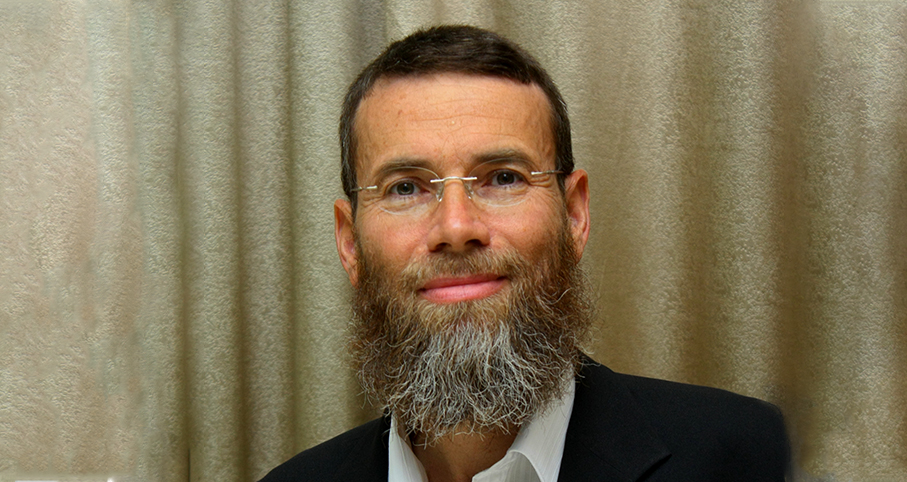Beit Midrash
- Shabbat and Holidays
- The Three Weeks
- The 17th of Tamuz
The Torah study is dedicatedin the memory of
Amram son of Sultana
2. The Seventeenth - A New Order
3. Getting to the Source of Things
4. Cause and Effect
5. The Tamid - Constant Ascent
The Eternal Significance of Fast Days
There is a tendency, on fast days, for people to concentrate upon the calamities of the past and on the stages that led up to the destruction of the Temple. People reflect on the distant past when they aught - says the Rambam - consider the present. It is true that these two aspects are not to be divorced from one another, and one should not think only about repentance but also mourn the destruction of the Temple. All the same, it is important to understand that the spiritual and moral shortcomings which lead to the destruction are not mere history; they have eternal significance. They rest at the foundation of all sorts of present-day weaknesses.
We must ask ourselves the question: If we already observe laws of mourning over the destruction, why is there a special day marking the breaching of the walls of Jerusalem, the beginning of the destruction, etc.?
The Seventeenth - A New Order
The Sages of the Mishnah mention events besides the beaching on the walls of the city: the Tablets of the Covenant were broken; the regular daily sacrifice was abolished, the wicked Apostomos burned a Scroll of the Law and placed an idol in the Temple of God. The Seventeenth of Tammuz is different than other fast days in that it mirrors the Ninth of Av. Five tragedies occurred on each one of them - together, ten. Ten is completeness. The Seventeenth of Tammuz constitutes a preparation for calamity; the Ninth of Av is the conclusion of calamity.
Jeremiah the Prophet writes that the walls of the city were breached on the ninth, and not on the seventeenth. How is this possible? According to the Babylonian Talmud, one date applies to the First Temple, the other to the second. According to the Jerusalem Talmud the records were confused. That the walls were breached on the ninth of Tammuz was a mistake in calculation due to the terrible hardships taking place at that time. This may be likened to a king who, while engaged in making calculations, was informed that his son had been taken captive. As a result the King said, "Let all further calculations begin from this date." All order was destroyed. Everything was overturned. This is what happened on the Seventeenth of Tammuz. A new order was established. From here on there exists an exilic order.
Getting to the Source of Things
The furthest back of the five events which took place on the Seventeenth of Tammuz was the Sin of the Golden Calf (i.e., the breaking of the Tablets); on the Ninth of Av, the Sin of the Spies.
The Or Sameach explains that what the Spies did was a greater transgression, for the Sin of the Golden Calf was expurged and rectified; furthermore, the laws of the Ninth of Av are more stringent. All the same, there is a side to the Sin of the Golden Calf which is more problematic. While this sin did not result in the destruction of an entire generation, it did leave in its wake a kind of eternal punishment. The Tablets of the Covenant were broken.
The Talmud (tractate Berakhot) relates the prayer of Moses in which he claims that if a chair of three legs (i.e., the Forefathers, Abraham, Isaac, and Jacob) is unable to stand before the Almighty, how is it possible for a chair of one leg to stand before Him? After this, the Talmud tells us that Moses’ prayer consisted of his sacrificing himself on behalf of Israel.
Rabbi A.I. Kook explains in his work "Ein Ayah" that Moses was a godly individual who ascended above everything. Nothing compares to him. It therefore would have been fitting for an entire nation to be created out of him. Yet, Moses could not find any purpose to life without Israel. He sacrificed himself for Israel, and, in this manner made himself a part of them and added to their completeness. Because he nullified himself for the sake of Israel he was unable to enter the Land, for the Jews themselves did not enter the land.
The three-legged chair can be seen as the ultimate source of all character traits and propensities in Israel, and we can see that they are more important than a chair with only one leg, i.e., Moses’ Torah. Moses, as a pillar unto himself, is without competition. But, as a foundation for the Jewish people, nothing comes close to the Patriarchs. The Sin of the Golden Calf reveals an inability to face the lofty holiness of the Giving of the Torah.
The bull represents the material side - the independence of the Jewish people without the Torah. Receiving the Torah was too high a climb for them. This sin is an expression of the furthest boundary of Israel’s abilities. It was an attempt at a complete connection between heaven and earth, and as such represented a trial for the Jews.
The Midrash tells us that the giving of the Tablets took place precisely at the moment that the Sin of the Golden Calf unfolded. The Sin of the Golden Calf was an expression of the capacity to receive. Therefore, God says that Moses is deserving but Israel is not deserving. Moses, though, says that this is not the most important factor. It is the sanctification of God’s name that counts - the sanctification of God’s name which results from the very existence of the Chosen People in the world, the progeny of Abraham, Isaac, and Jacob. Let them receive what they are capable of from the Torah, even if they are not on the most appropriate level. The breaking of the Tablets contains a message of a changed leadership for Israel, and a transition to a path of suffering and complications. This, then, is the Seventeenth of Tammuz - it paves the way to the Ninth of Av.
Cause and Effect
The Talmud continues, telling us that Moses prayed until he became ill. Rabbi Kook explains that in order to rectify the Sin of the Golden Calf supernatural strength was necessary. The Ninth of Av is more severe: While the Seventeenth of Tammuz is the cause - the constriction and inability of the Jewish people to endure all of the demands - the Ninth of Av is the actual and real result of these shortcomings.
Yet, it is the Almighty that determines the direction of history, not the Jewish people. All of creation is dependent upon the Jews, but they are a mere vessel for the appearance of the Almighty. In this sense the Jews are without flaw - they are absolutely perfect, for, "No matter what, they are called ‘[God’s] children.’" But in practice, in this world, there are weaknesses and boundaries. This is the Seventeenth of Tammuz, the root of all failure and weakness.
The Ninth of Av, the day on which the Holy Temple was destroyed, would appear to represent a blow to Israel’s chosenness - to the "three-legged chair" which remained even after the Sin of the Golden Calf. When that generation rejected the Holy Land it became clear that it would be impossible for the nation to participate in the divine process that was supposed to unfold, and that it would have to be some other generation. This rejection spelled an obstruction to the Jewish people’s connecting with the world. True, there was destruction, but in the sense of "He took out his anger upon sticks and stones." There is alternate program for the exilic era, a nullification of existence in order to arrive at a new existence and to the Third Temple. According to Rabbi Elazar, Moses begged the Almighty to forgive the Children of Israel to the point that he became sick. What this amounts to is that there is a defect in the completeness of God’s rule in the world. Moses requested that Israel’s existence perpetuate, even if it be riddled with complications. He desired that Israel of the First Tablets continue to exist with the Second Tablets, only in a different manner. All of the reasons for the Seventeenth of Tammuz are, in essence, Torah-centered. There is the failure to attain the necessary spiritual capacity.
Yet there exists an even deeper way of viewing things. It calls for seeing beyond Israel in their actual manifestation, and seeing them in potential, in essence - "Segulat Israel." For this reason all procedures must be carried out in a more complicated manner - sick, as it were. The Ninth of Av represents a fall for the soul, and hence contains an element of comfort. On this day there is complete destruction, and this incision demands rectification. For this reason comfort and consolation are embedded in that very day. The Seventeenth of Tammuz, on the other hand, displays deficiency and weakness.
The Tamid - Constant Ascent
Israel’s strength, explains Rabbi Kook, lies in the "Tamid" daily sacrifice of two lambs, one in the morning and one in the afternoon. This event takes place inside the Holy Temple. We are all familiar with momentary and fleeting exaltation, but continuous and constant ascent is dependent upon the force of the daily Tamid sacrifice. Elevation - one level after another. We elevate this innate purity and calm which reside within. And the source of these qualities is the eternity of the Tamid sacrifice. The Torah is likened to sparks of prophecy which temporarily elevate the individual, but this is a form of worship, always, in every situation and every manner. Everything becomes tied to sanctity. This fixedness is capable of profound accomplishment and it is the greatest of all qualities.
The real damage of the destruction of the Temple was that which was caused to the constant drawing of holiness via the daily sacrifice, and we earnestly await complete rectification and the elation of the return of the Temple to its place and the return of a constant and complete existence.
Rabbi Isaiah Horowitz, known as "Shlah" from the initials of his chief work, teaches that the Hebrew word "keren," or beam of light, appears in ten places: Once in relation to Isaac, once in relation to Jacob, to David, etc. With the destruction of the Temple, these beams were taken away and given to the nations. Yet what right do the nations of the world have to these spiritual crowns of the righteous?
The Shlah explains that what is meant by their having been given these illuminating facets is that they possess the capacity to completely smother these qualities, these "rays." While it is true that the exile brought the dispersal and downtroddeness of the Jewish people, it also allowed for the possibility of sanctifying God’s name in the midst of the nations, and gathering the sparks of holiness and good from the entirety of humankind. In the future, the force of power invested in these days will be transformed into sacred forces, and these days will become holidays for Israel.

What Do We Lack With No Temple?
Translated by Hillel Fendel
Rabbi Elad Brand | Tammuz 10 5781





















